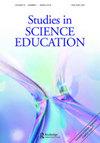Evidence for effective uses of dynamic visualisations in science curriculum materials
IF 9.9
2区 教育学
Q1 EDUCATION & EDUCATIONAL RESEARCH
引用次数: 97
Abstract
Dynamic visualisations capture aspects of scientific phenomena that are difficult to communicate in static materials and benefit from well-designed scaffolds to succeed in classrooms. We review research to clarify the impacts of dynamic visualisations and to identify instructional scaffolds that mediate their success. We use meta-analysis to synthesise 47 independent comparisons between dynamic and static materials and 76 comparisons that test the effect of specific instructional scaffolds. These studies show that dynamic visualisations are better than static visuals at promoting conceptual inferences about science, consistent with the success of inquiry instruction in science. To realise this potential of dynamic visualisations, instruction needs to help students use the dynamic visualisation to make sense of their own ideas. Scaffolds that are most successful include prompts for reflection, prompts to distinguish among parts of the visualisation, visual cues that identify salient features, multiple visualisations presented sequentially, and interactive features that govern the pacing of activities. We extract guidelines from this research to help researchers plan future studies of visualisations, designers create and refine instructional materials using visualisations, and practitioners customise instruction that features visualisations.在科学课程材料中有效使用动态可视化的证据
动态可视化捕捉了在静态材料中难以传达的科学现象的各个方面,并受益于精心设计的支架,从而在课堂上取得成功。我们回顾了研究,以澄清动态可视化的影响,并确定了介导其成功的教学脚手架。我们使用荟萃分析综合了47个动态和静态材料之间的独立比较,以及76个测试特定教学支架效果的比较。这些研究表明,在促进科学概念推理方面,动态可视化比静态视觉效果更好,这与科学探究教学的成功相一致。为了实现动态可视化的这种潜力,教学需要帮助学生使用动态可视化来理解他们自己的想法。最成功的框架包括反思提示、区分可视化部分的提示、识别显著特征的视觉线索、顺序呈现的多个可视化以及控制活动节奏的互动特征。我们从这项研究中提取指导方针,以帮助研究人员规划可视化的未来研究,设计师使用可视化创建和完善教学材料,从业者定制具有可视化特征的教学。
本文章由计算机程序翻译,如有差异,请以英文原文为准。
求助全文
约1分钟内获得全文
求助全文
来源期刊

Studies in Science Education
EDUCATION, SCIENTIFIC DISCIPLINES-
CiteScore
15.30
自引率
2.00%
发文量
7
审稿时长
>12 weeks
期刊介绍:
The central aim of Studies in Science Education is to publish review articles of the highest quality which provide analytical syntheses of research into key topics and issues in science education. In addressing this aim, the Editor and Editorial Advisory Board, are guided by a commitment to:
maintaining and developing the highest standards of scholarship associated with the journal;
publishing articles from as wide a range of authors as possible, in relation both to professional background and country of origin;
publishing articles which serve both to consolidate and reflect upon existing fields of study and to promote new areas for research activity.
Studies in Science Education will be of interest to all those involved in science education including: science education researchers, doctoral and masters students; science teachers at elementary, high school and university levels; science education policy makers; science education curriculum developers and text book writers.
Articles featured in Studies in Science Education have been made available either following invitation from the Editor or through potential contributors offering pieces. Given the substantial nature of the review articles, the Editor is willing to give informal feedback on the suitability of proposals though all contributions, whether invited or not, are subject to full peer review. A limited number of books of special interest and concern to those involved in science education are normally reviewed in each volume.
 求助内容:
求助内容: 应助结果提醒方式:
应助结果提醒方式:


